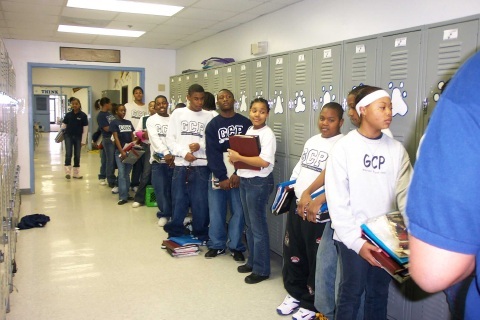
NC Congressman Mark Walker speaks in Greensboro, NC on October 18, when Revolution Mill received an award from Preservation NC.
The U.S. House Ways & Means Committee has now released draft legislation with proposed tax changes. Many aspects of this draft will be hotly debated, but here I want to focus on two items in particular. If enacted, the Committee's proposal would eliminate the New Markets Tax Credit and the Historic Preservation Tax Credit -- tax incentives with a proven track record for generating jobs and economic growth.
The New Markets Tax Credit (NMTC) is a great example of a government investment that produces benefits well above its costs. Through NMTC, the federal government offers tax credits to incent economic investment to help revitalize low-income communities and neglected areas, both urban and rural.
For every one dollar of federal investment, NMTCs have generated $8 of private investment. Nationwide, tax credits have been leveraged to finance over 5,400 businesses, creating 178 million square feet of manufacturing, office and retail space.
North Carolina has been part of that success. Between 2003 and 2014, NMTC investments of $838 million produced more than one billion dollars in investments from other sources. During that period, 93 businesses and economic revitalization projects received NMTC financing. Those investments created 18,694 construction jobs and 6,892 permanent jobs.
Self-Help has been an active NMTC participant since Congress enacted the program with bipartisan support in 2000. Examples of Self-Help NMTC projects in North Carolina include loans to high-achieving charter schools that serve low-income students such as Neuse Charter School (Smithfield), KIPP Gaston Prep and Henderson Collegiate. We also leveraged NMTC credits as a lender on the American Tobacco complex, which helped spur the revitalization of downtown Durham.
When paired with other government initiatives, the economic impact of NMTCs becomes even stronger. For instance, many of Self-Help’s charter school loans are in hard-to-serve rural communities. Combining US Dept. of Agriculture programs with NMTCs allows Self-Help to provide financing to rural schools in areas that typically draw very little investment.

KIPP Gaston Prep students line up for a class.
NMTCs are also a powerful partner with federal and state Historic Preservation Tax Credits, which make historic rehabilitation projects economically viable. For example, Self-Help has renovated two vacant, historic public school buildings in East Durham to create spaces for two Durham charter schools, Maureen Joy and KIPP Durham.
Self-Help is currently working on two other East Durham projects using these programs—the renovation of the historic WG Pearson School for Student U and a project on the corner of Angier and Driver Streets to provide needed childcare facilities, entrepreneurial space and offices for the East Durham Children’s Initiative. The economics of these projects would not have worked without both NMTCs and historic tax credits. The same is true of the historic revitalization of Revolution Mill in Greensboro as well as Golden Belt in Durham.
Government spending has always been a convenient punching bag. As Congress considers tax reform it’s important to make clear the impact of proven and effective, if lesser known, initiatives such as NMTCs in addition to higher-profile programs such as Historic Tax Credits and prevent the proverbial baby from being thrown out with the bathwater.
Tucker Bartlett, executive vice president, has served on Self-Help’s staff since 2000.